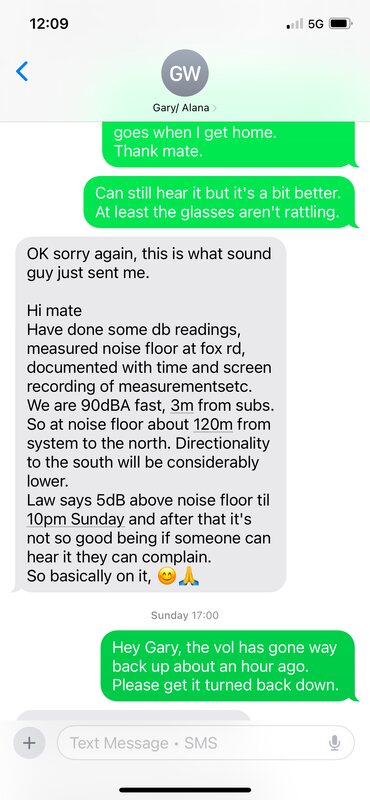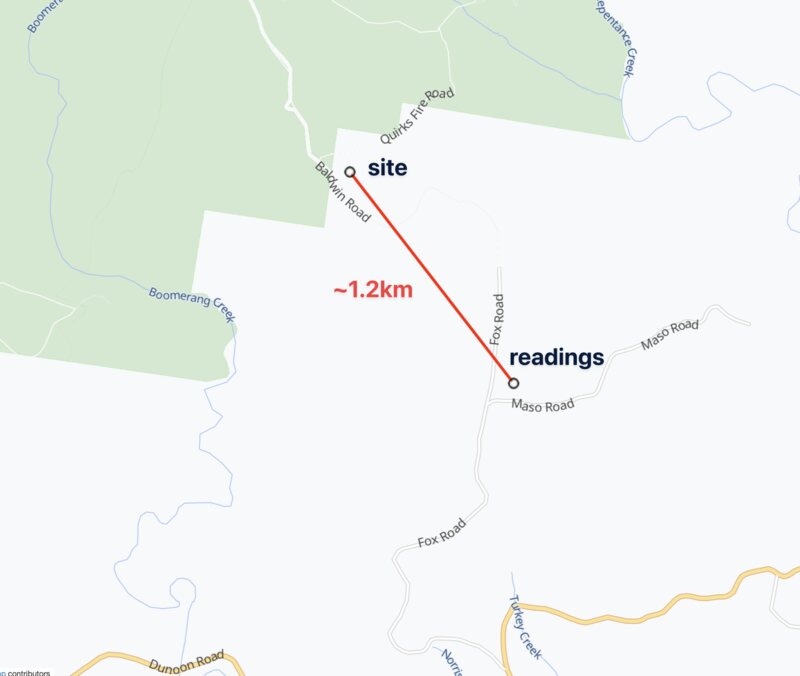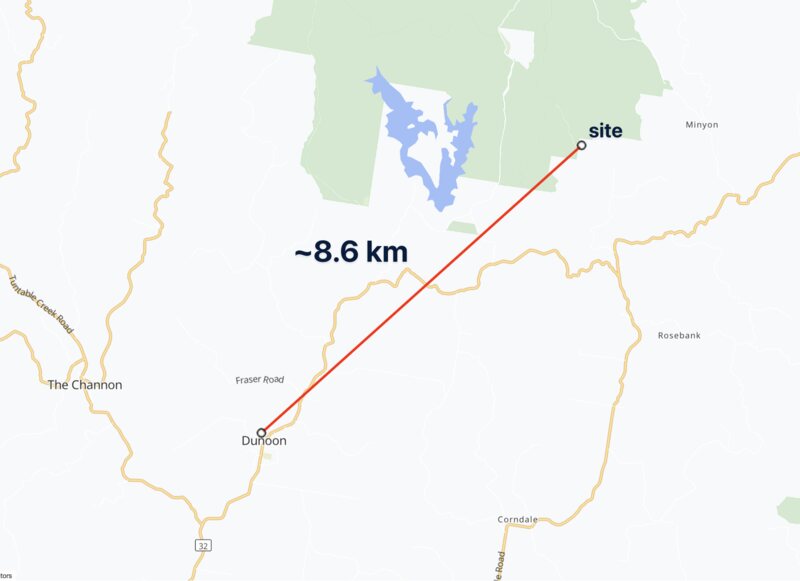Excessive and Persistent Noise Pollution
The sound systems at these events have grown progressively bigger and louder. What residents experience is not music enjoyment but industrial-grade noise pollution that persists for extended periods.
The Nature of the Noise
What residents hear is characterized by:
- Repeated pounding in the 50-200 Hz range (low frequency bass)
- Duration of 8 to 36+ hours depending on the event
- Bass levels at approximately twice the volume of the rest of the mix
- Sound quality akin to industrial noise rather than music
Residents report that they can sometimes hear the doof while in bed, with the door closed and earplugs in. This is not ambient background noise—this is intrusive, unavoidable sound pollution.
Geographic Impact
The impact varies by location:
- People down the hill on Maso Road have a mountain between them and the noise source
- Those in the valley and on the ridge receive the full brunt of the noise directly
- Distance provides little relief—measurements taken approximately 1 km from the site still show excessive levels
Documented Evidence
Comprehensive noise monitoring has been conducted, with evidence showing:
- 30+ dB over background noise in low frequencies
- Worst readings around 63 Hz
- Measurements taken approximately 1.2 km from the event site
- Multiple events documented with consistent patterns
The "Noise Floor" Claim vs. Reality

Event organisers have made claims about the sound system's impact radius that are demonstrably false. In communications with residents, the sound engineer stated that measurements showed the "noise floor" (where the sound becomes inaudible) was at approximately 120 meters from the system.
The problem: Residents are experiencing significant noise pollution over 1,200 meters (1.2 km) from the site—over 10 times the claimed noise floor distance. Documented measurements at this distance show 30+ dB over background noise, which is 6 times the NSW legal threshold for noise nuisance.
This massive discrepancy between the claimed 120m noise floor and the reality of audible, measurable, and disruptive noise at over 1km demonstrates either:
- A fundamental misunderstanding of sound propagation and measurement
- Sound levels far exceeding what the operator claims or realizes
- Inadequate measurement methodology
- All of the above
Whatever the cause, it's clear that claims of minimal noise impact are not based in reality, and the community is experiencing noise pollution at distances nearly 10 times greater than the operator suggests is even possible.
Video Evidence
This video demonstrates noise monitoring data from 4 separate events this year (2025), compared against the typical noise floor (background noise level). The video clearly shows the dramatic impact when the bass kicks in, with noise levels spiking well above acceptable thresholds. It also includes readings taken inside residences behind closed doors, demonstrating that even indoor spaces offer little refuge from the noise pollution. Readings taken outside at monitoring site 1.2 km from festival site, except where titles indicate the specific conditions and locations of each measurement.
Documentation showing noise monitoring data across multiple events
Monitoring Location
The documented noise measurements were taken at a residence approximately 1.2 km from the event site. This location experiences direct line-of-sight exposure to the sound system, with no significant geographical barriers to block the noise.
At this distance, measurements consistently show 30+ dB over background noise in low frequencies, particularly around 63 Hz. This level of noise pollution is 6 times higher than the NSW legal threshold for noise nuisance (5 dB over background).

Extended Impact Range: Reports from Dunoon
The noise impact extends far beyond the immediate vicinity. Anecdotal evidence indicates that the bass from these events has been clearly audible in Dunoon, approximately 8.6 km away from the event site.
This demonstrates the extraordinary reach of low-frequency noise from these events. When compared to the sound engineer's claim of a 120m "noise floor," the reality of audible bass at 8,600 meters (8.6km) represents a discrepancy of over 70 times the claimed distance.
The fact that bass frequencies are carrying this far indicates:
- Sound levels at the source are extremely high
- Low-frequency bass propagates much further than operators realize or acknowledge
- The impact area encompasses a significant portion of the surrounding region
- Many more residents are affected than just those in the immediate vicinity

Legal Standards
In NSW, a noise is generally considered a nuisance if it's more than 5 dB over background noise. The documented levels of 30+ dB over background clearly breach this standard by a factor of six or more.
There are specific laws regarding:
- What constitutes offensive noise
- When you can and cannot make noise
- Permissible noise limits
Pretty much all of these regulations are being breached at some level during these events.
Impact on Residents
- Inability to sleep without earplugs during events
- Noise intrusion even with earplugs and closed doors
- Disruption to daily activities for the entire duration
- Stress and health impacts from prolonged exposure
- Loss of peaceful enjoyment of property
One-offs vs. Frequency
While a single instance of loud music might be tolerable as an occasional community event, the increasing frequency of these parties transforms them from one-off nuisances into an ongoing pattern of noise pollution that significantly impacts quality of life.